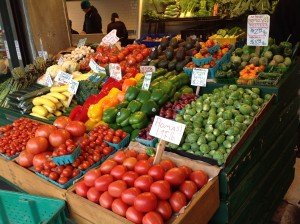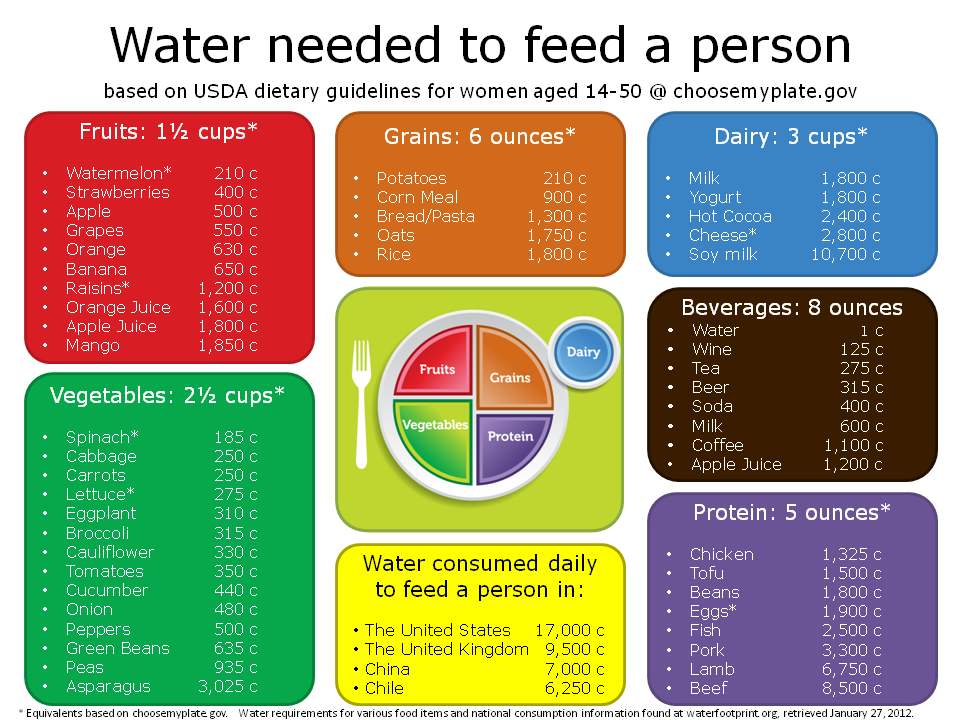 It is possible to reduce water consumption to levels approaching zero for many industrial processes. However when a plant uses water, water losses through transpiration/evaporation is fundamental to the health of the plant. It is evaporation of water from the pores (or stoma) in the leaves that powers the movement of water and nutrients from the roots up the stems and out to leaves.
It is possible to reduce water consumption to levels approaching zero for many industrial processes. However when a plant uses water, water losses through transpiration/evaporation is fundamental to the health of the plant. It is evaporation of water from the pores (or stoma) in the leaves that powers the movement of water and nutrients from the roots up the stems and out to leaves.
As the foods we eat ultimately gain their energy from plants, the water footprint of plants is a logical place to start to gain understanding.
The Problem with Data
The folks at the water footprint network have done a lovely job of cataloguing the amount of water required to grow or feed food, to include the water required to dilute fertilizer leachate back to clean water standards. The Water Footprint Network has databases available for download containing the required water footprint across major foods and different countries.
It’s a geek’s dream as far as raw data is concerned. However the numbers are all reported in terms of cubic meters of water required for a metric ton of the product. Due to the beautiful nature of metric, this will also be the number of liters required for a kilogram of product.
Even so, most people don’t eat a kilogram of anything at one sitting, nor do they track the number of kilograms of a product they consume across multiple sittings.
The useful measure of consumption is the serving. But a serving of grapes will be a different weight from a serving of lettuce. So it becomes necessary to take the weight of an individual serving, compute the water footprint for that serving, and compare these footprints across multiple different foods in a category. Below is a table I put together in 2012 to show the amount of water required to produce an entire day’s recommended amount of different kinds of foods:

As I believe I’ve mentioned, this table isn’t entirely correct. Most notably, the water footprint for soy milk was likely based on the amount of water required for a kilogram of soy milk powder, since other articles indicate plain soy milk has a lower water footprint than an equivalent volume of “bovine” milk.
Trends in Water Consumption for Fruits and Vegetables
Not all fruits and vegetables are created equal.
If you’re looking to minimize water footprint, you do well to concentrate on fruits and veggies that represent a large portion of the plant. Lettuce and spinach are winners here, particularly when you remember that the USDA recommended serving for these leafy green vegetables is twice as large as other kinds of veggies.
A close runner up are root vegetables, like carrots and potatoes. Parsnips, radishes, and the like would have similarly low water footprints per serving.
Fruits follow leafy greens and root vegetables in the hierarchy of low water footprint for a serving. Here I use the botanical definition of fruit, the fleshy part of a flowering plant that contains seeds. So in addition to apples and oranges, this category includes tomatoes, cucumbers, and squash.
The “veggies” that require the largest water footprint as a class are the actual seeds themselves. This includes peas, beans, various nuts, and grains.
The outlier in this table is asparagus. The thing with asparagus is that it takes a plant years to produce the edible portion of the plant. Fruit trees similarly take a year or so before they produce fruit, but in the case of fruit trees the fruit will continue to appear on an annual basis for many years after the first harvest. Apparently that isn’t the case for asparagus.
To Juice or Not To Juice
Fresh fruits and vegetables have the lowest water footprint for any family of food products related to a particular kind of plant.
To illustrate this point, we can look at the water footprint of an orange compared to the water footprint of a “serving” of orange juice. Because juice is more compact and we drink it like water, the folks who create these USDA serving recommendations don’t limit a serving to the amount of juice you’d get from a single orange. It would take 2-3 oranges to produce the cup of juice that counts as a serving.
Besides, how many of us limit ourselves to a single cup of juice? We’re usually chugging down a delightful concoction that boasts of the large variety of whole fruits and vegetables in a single bottle. We’re promised all kinds of phytonutrients and antioxidants. This is a lovely thing, but it comes at a cost.
Besides the water cost of the juice itself, fruit and veggie juices are often high in sugars that are no longer balanced by the pulp discarded in the juicing process.[ref]A form of pre-planned food waste, if you will.[/ref] Independent of what sugars might do to our waists, the large amount of sugar in juices tends to create a sugar spike that triggers a release of insulin to suppress the sugars (since ingesting that much sugar isn’t a natural phenomenon, and the body “assumes” something is wrong). Once the sugars are gone, the insulin causes blood sugars to plummet. We feel woozy and tired.
For many of us, this fatigue causes us to reach for something else to eat, to give us another bit of energy. This additional bit of food is something we crave because we just ate something un-natural in the millennia of human evolution prior to our times.
Juice is not evil. You won’t go to hell for drinking it. But it isn’t the best choice. As we move towards a future where resources become even more scarce, insistence on drinking our fruits and veggies becomes ever more irresponsible.
A Tempest in a Teapot?
I was introduced to the concept of Water Footprint in 2012, when I came across the United Nations campaign for World Water Day in 2012.
The United Nations’ Food and Agriculture Organization (UN FAO) put together a very nice brochure covering important aspects of the threat to our ability to equitably feed the world’s population, and the challenges facing the world.
I am not a government, or a state, or even in a position to force all members of my family to eat as I believe to be ethically responsible.
But for here and now, I can choose to eat whole fruits and vegetables, and I can choose to make these water-thrifty types of food a larger portion of my daily diet. As I do so, I can reduce my personal pressure on the world’s water supply and thereby reduce suffering associated with lack of water I might otherwise create through my consumption.



New Post: The Compassionate Mormon: Water for fruits and vegetables: It is possible to reduce wat… http://t.co/knHdWURswc #LDS #Mormon
TheMillennialStar: The Compassionate Mormon: Water for fruits and vegetables http://t.co/lmYHw2Wruc #lds #mormon
Meg, I think these posts are praiseworthy, and I think people should take individual steps to decrease water consumption. As I have stated in the past, there are dangerous signs that countries will be fighting over water in the decades to come.
In the meantime, I am wondering if you have considered that there is something absolutely huge that Utah residents could do to save 1.7 million gallons of water a day, which is to cut off water to the NSA spying center in Utah?
http://www.theguardian.com/world/2014/feb/12/utah-lawmaker-nsa-data-centre-water-supply
I’m sure everyone can identify a business or organization with which they disagree and say “cut them off!”
However I do recommend people get familiar with the Serenity Prayer, which as I recall goes something like:
God, grant me
– the serenity to accept the things I cannot change,
– the courage to change the things I can change, and
– the wisdom to know the difference.
As for me and my house, we do not have the power to change the amount of water a large organization/business in Utah might expend in support of operations.
Thanks.
RE: Geoff, residents cutting off water to their lawns (or even just a tiny portion of them – residents or parts of lawns – would save orders of magnitude more water than cutting off the NSA. 😉